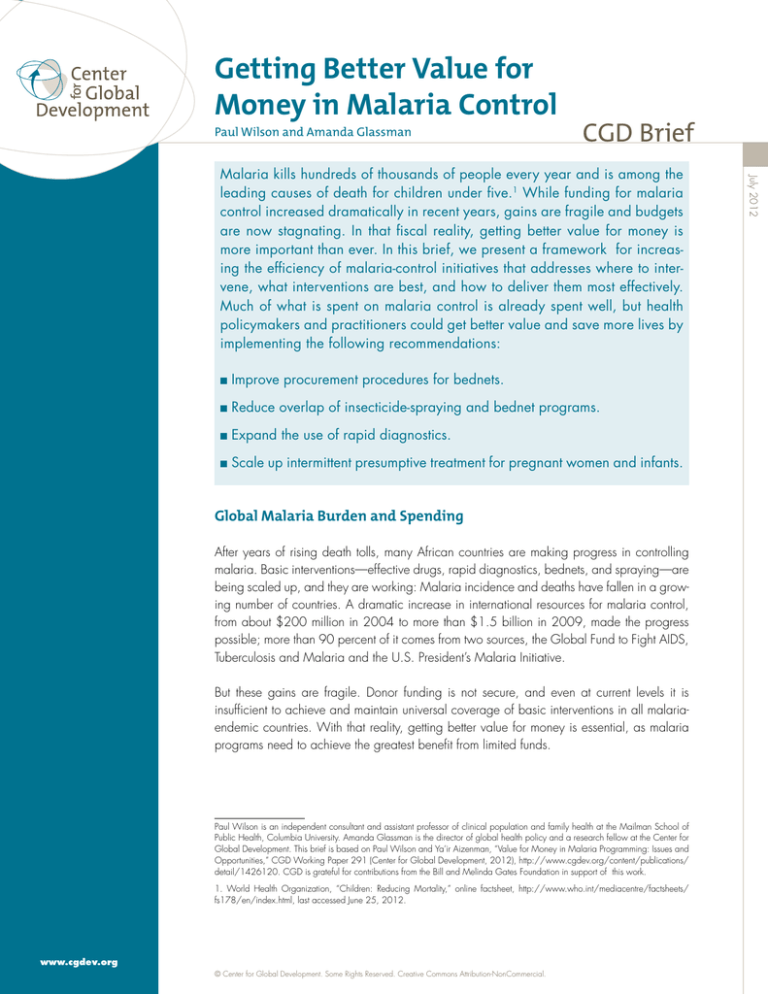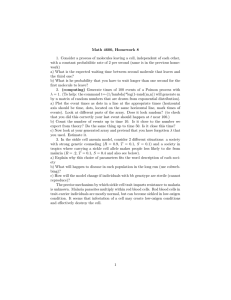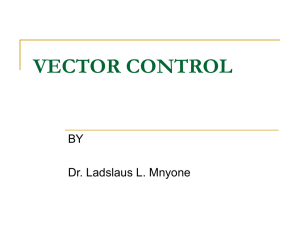
Getting Better Value for
Money in Malaria Control
Paul Wilson and Amanda Glassman
CGD Brief
n Improve
procurement procedures for bednets.
n Reduce
overlap of insecticide-spraying and bednet programs.
n Expand
the use of rapid diagnostics.
n Scale
up intermittent presumptive treatment for pregnant women and infants.
Global Malaria Burden and Spending
After years of rising death tolls, many African countries are making progress in controlling
malaria. Basic interventions—effective drugs, rapid diagnostics, bednets, and spraying—are
being scaled up, and they are working: Malaria incidence and deaths have fallen in a growing number of countries. A dramatic increase in international resources for malaria control,
from about $200 million in 2004 to more than $1.5 billion in 2009, made the progress
possible; more than 90 percent of it comes from two sources, the Global Fund to Fight AIDS,
Tuberculosis and Malaria and the U.S. President’s Malaria Initiative.
But these gains are fragile. Donor funding is not secure, and even at current levels it is
insufficient to achieve and maintain universal coverage of basic interventions in all malariaendemic countries. With that reality, getting better value for money is essential, as malaria
programs need to achieve the greatest benefit from limited funds.
Paul Wilson is an independent consultant and assistant professor of clinical population and family health at the Mailman School of
Public Health, Columbia University. Amanda Glassman is the director of global health policy and a research fellow at the Center for
Global Development. This brief is based on Paul Wilson and Ya’ir Aizenman, “Value for Money in Malaria Programming: Issues and
Opportunities,” CGD Working Paper 291 (Center for Global Development, 2012), http://www.cgdev.org/content/publications/
detail/1426120. CGD is grateful for contributions from the Bill and Melinda Gates Foundation in support of this work.
1. World Health Organization, “Children: Reducing Mortality,” online factsheet, http://www.who.int/mediacentre/factsheets/
fs178/en/index.html, last accessed June 25, 2012.
www.cgdev.org
© Center for Global Development. Some Rights Reserved. Creative Commons Attribution-NonCommercial.
July 2012
Malaria kills hundreds of thousands of people every year and is among the
leading causes of death for children under five.1 While funding for malaria
control increased dramatically in recent years, gains are fragile and budgets
are now stagnating. In that fiscal reality, getting better value for money is
more important than ever. In this brief, we present a framework for increasing the efficiency of malaria-control initiatives that addresses where to intervene, what interventions are best, and how to deliver them most effectively.
Much of what is spent on malaria control is already spent well, but health
policymakers and practitioners could get better value and save more lives by
implementing the following recommendations:
Getting Better Value for Money in Malaria Control
2
Figure 1. A framework for increasing value for money for malaria prevention
Where do we intervene?
What do we do?
How do we do it?
• Choice of countries
• Spatial targeting within countries
• Allocation of resources among vector control,
treatment, diagnosis, surveillance
• Choice of specific interventions
• Delivery efficiency
• Commodity costs
• Administrative and aid efficiency
A Framework for Increasing Efficiency
The value for money spent against malaria results from three
kinds of decisions: where to intervene, what to do, and how
to do it (see figure 1).
Spatial targeting happens at the international level, as donors allocate aid among countries, and at the country level,
as program officers decide where to focus resources, especially for disease-vector control. As malaria transmission
can vary greatly based on location, these decisions have
important implications for efficiency.
At the same time, donors and program officials must make
decisions about allocative efficiency, or which interventions
to provide in which circumstances. As with spatial targeting,
these choices are most pronounced in vector control, since
the appropriateness of insecticide-treated bednets, indoor
residual spraying, and other interventions varies from place
to place. Some activities, such as diagnosis and efforts to
change behavior, influence value for money in part by making other prevention or treatment interventions more effective
or less costly.
The way that malaria interventions are implemented affects
efficiency through several channels, each of which has a
bearing on value for money. Delivery efficiency can be optimized by choosing the most efficient ways to bring commodities or services to those who need them, particularly
when providing preventive and case management services.
At the international level, costs can be minimized by efficient
procurement of bednets and other commodities and by altering market structures or helping suppliers reduce manufacturing costs. Potential gains in efficiency based on aid or
donor implementation styles are reflected in the large differences in cost between models of aid delivery, such as the
relatively hands-on U.S. model and the proposal-driven and
country-implemented Global Fund model. Finally, administrative efficiency subsumes a range of important dimensions
of program implementation, including the quality of program
management as well as the extent of fund or commodity
diversion.
Recommendations
There is little chance of transformative efficiency gains in
malaria programming in the short to medium term. This
conclusion derives primarily from the need to sustain high
coverage of vector control interventions even in relatively
low-risk areas. There are nonetheless some opportunities for
meaningful improvements in value for money, including the
following:
n
Improved procurement procedures for bednets. Vector control is already the most important target of malaria spending, and its share can be expected to rise as
vector-control interventions are scaled up and treatment
costs fall. More efficient procurement, including pooled
n
n
n
Reduced overlap of spraying and bednet programs.
Evidence shows that bednets and spraying are both effective in reducing malaria incidence. Although the two
interventions are increasingly combined in high-transmission areas to drive down the incidence of malaria more
rapidly or more completely than either could do on its
own, there is little rigorous evidence on the incremental benefits of combination. The stakes are quite high: If
in fact there is little additional benefit from combination,
there are potentially large savings from forgoing indoor
residual spraying in areas with high bednet coverage or
from restricting free net distribution in areas where spraying is judged to be the superior intervention. Reducing
the overlap of net and spraying programs, at least until
we know more about the costs and benefits of combining
the two interventions, could save 5 percent or more on
vector-control expenditure.
Expanded the use of rapid diagnostics. The use of Rapid
Diagnostic Tests (RDTs) as a replacement for presumptive
treatment offers the potential to improve patient outcomes
through more appropriate treatment of nonmalarial fevers
while slowing the development of drug resistance. These
effects are potentially decisive: Shilcutt et al.’s detailed
analysis found that RDTs would have a 95 percent likelihood of being cost-effective relative to presumptive diagnosis at any prevalence below 62 percent.2 Expanding
the use of RDTs and strengthening adherence to test results
could cut expenditure on case management commodities such as pharmaceuticals in some areas, but would
improve the quality of fever treatment in all areas.
Scaled-up intermittent presumptive treatment for pregnant women and infants. Intermittent preventive treatment
(a form of prevention) involves giving pregnant women
2. Samuel Shillcutt et al., “Cost-Effectiveness of Malaria Diagnostic Methods in SubSaharan Africa in an Era of Combination Therapy,” Bulletin of the World Health Organization 86(2): 81–160.
and infants doses of relatively inexpensive antimalarials
such as sulfadoxime-pyrimethamine to purge parasites
from their system. It is exceptionally cost-effective in areas
of high transmission. Studies in Tanzania have found that
treatment for infants in concert with vaccines costs just
$0.68 and $1.57 per malaria case averted,3 and as
little as $2.90 per disability-adjusted life year (DALY)
averted.4 Treatment for pregnant women has been shown
to have incremental cost-effectiveness ratios as low as
$1.02 per DALY averted.5 Despite its affordability and
demonstrated effectiveness, coverage of intermittent preventive treatment is currently low: The WHO estimates
from household surveys that only 23 percent of pregnant women in sub-Saharan Africa received two doses
of antimalarials in 2009–2011, in part because of low
antenatal care attendance.6 Increasing coverage of treatment for pregnant women and introducing it for infants
on a larger scale in high-burden areas would be highly
cost-effective.
Conclusions
Malaria control is a very good investment. Numerous studies have already established that the interventions on which
malaria programs increasingly rely and that account for the
great bulk of donor’s spending on malaria—insecticidetreated bednets, indoor residual spraying, treatment with
artemisinin-combination therapy—are highly cost-effective.
However, as global health budgets become increasingly
constrained, methods to improve value for money need to
be identified and exploited to maximize inputs. The aforementioned recommendations would make the most of specific efficiencies in malaria control, allowing for the better
treatment and prevention of malaria within existing budgets.
3. L. Conteh et al., “The Cost-Effectiveness of Intermittent Preventive Treatment for Malaria in Infants in Sub-Saharan Africa,” PLoS ONE 5 (6): e10313. doi:10.1371/
journal.pone.0010313. PMC 2886103. PMID 20559558; G. Hutton et al., “CostEffectiveness of Malaria Intermittent Preventive Treatment in Infants (IPTi) in Mozambique
and the United Republic of Tanzania,” Bulletin of the World Health Organization 87
(2): 123–129. doi:10.2471/BLT.08.051961. PMC 2636201. PMID 19274364.
4. Conteh, et al., “The Cost-Effectiveness.”
5. E. Sicuri, “Cost-Effectiveness of Intermittent Preventive Treatment of Malaria in Pregnancy in Southern Mozambique,” PLoS ONE 5 (10): e13407. doi:10.1371/journal.
pone.0013407. PMC 2955525. PMID 20976217.
6. WHO, World Malaria Report 2011 (Geneva: WHO, 2011), 35. Available at
http://www.who.int/malaria/world_malaria_report_2011/en/index.html.
3
July 2012
procurement, could save up to 10 percent of bednet
costs. There would be some savings, in both the short
and long run, from consolidating demand on a small
number of net types, but these gains must be balanced
against losses in quality or in fit to local conditions and
preferences.
The
Center
for
Global Development
poverty and inequality through rigorous
engagement with the
policy
works to reduce global
research
and active
community to make the world a more
prosperous, just, and safe place for us all. The policies and practices of
the United States and other rich countries, the emerging powers, and
international institutions and corporations have
significant impacts
on the developing world’s poor people. We aim to improve these policies
and practices through research and policy engagement to expand
opportunities, reduce inequalities, and
www.cgdev.org
Getting Better Value for
Money in Malaria Control
Paul Wilson and Amanda Glassman
CGD Brief
July 2012
improve lives
everywhere.




